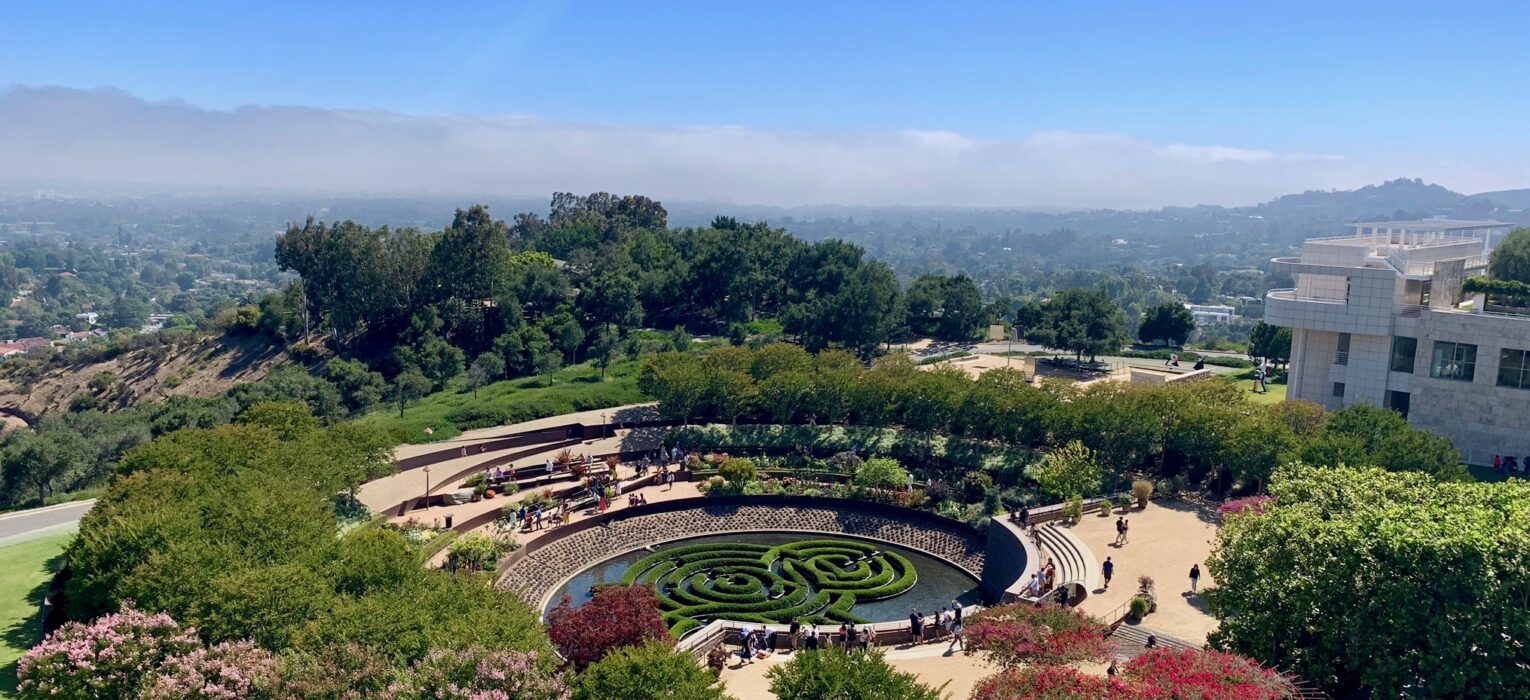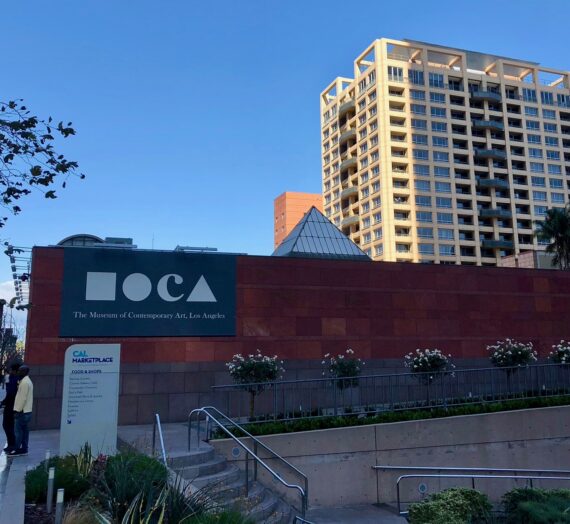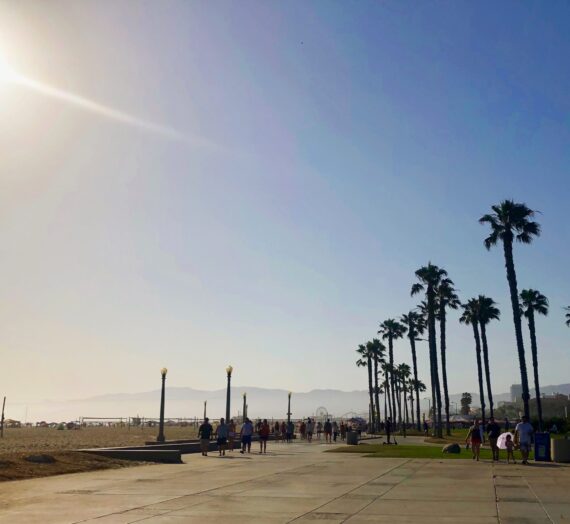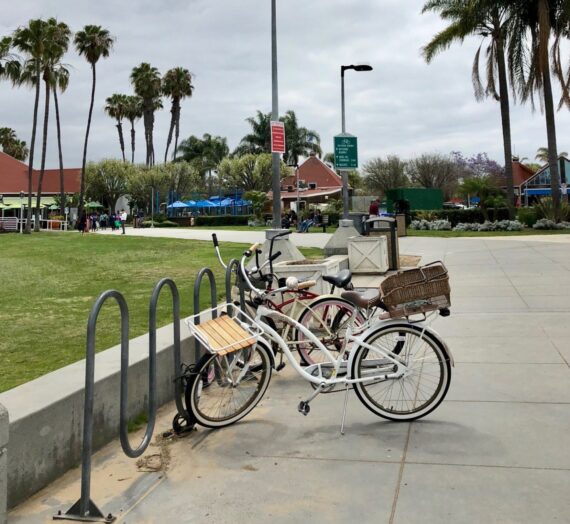You really can’t discuss art in Los Angeles without talking about the Getty Museums. If you’ve begun researching museums to visit in LA, you’ve likely heard of them. The Getty museums include the Getty Center, perched high in the Sepulveda Pass overlooking the city, and the Getty Villa, located atop a seaside bluff in Pacific Palisades. The museums are home to permanent collections ranging from ancient Rome to the modern day, captivating rotating exhibitions, and a variety of local events, all on beautiful grounds.
Here’s everything you need to know to plan your visit to the Getty Center and the Getty Villa in Los Angeles.

The Getty Center
About the Getty Center
The Getty Center is situated on the most valuable piece of property in Los Angeles County. From its mountaintop in the Sepulveda Pass, the museum overlooks the entire city. As you wander the grounds of the Getty Center, you’ll be treated to views of the valley, mountains, and urban sprawl below.
The Getty Center opened to the public in 1997, but it was in the works long before that. J. Paul Getty began collecting artwork decades earlier and added a museum wing to his home during the 1950s. Getty then built a replica of an Italian villa to house the art during the 1970s (which is home of the Getty Villa today). The sheer size of the collection and desire for it to be accessible to the public led the Getty Trust to find a new home for all the art over the following years. The current property was found and purchased, where construction began in 1989 and the Getty Center opened nine years later.
Today, the Getty Museum is home to art, architecture, garden, and special events.
The art on display at the Getty includes its permanent collection and rotating exhibits. The permanent collection includes pre-20th century European paintings and manuscripts, American photography, and modern sculptures, among other pieces. The rotating exhibits vary, but the museum is currently hosting the Book of Beasts, a fascinating journey through medieval bestiaries.
Another draw of the Getty Center is its unique architecture and garden. The museum was designed by Richard Meier in the 1980s. The architecture is characterized by white buildings with curved lines and large windows. Complimenting the center’s architecture is its beautiful gardens. The museum garden was designed by Robert Irwin and features circular shapes and a variety of foliage, all with wonderful city views.
Finally, the museum also hosts a variety of events. Tours, talks, film screenings, performances, and family activities all take place at the Getty. One recent talk was, “Intro to Care of Magical Creatures: The Bestiary and Harry Potter,” an awesome discussion on the connection between the medieval bestiaries on display in the Book of Beasts exhibit and the creatures of the Harry Potter universe. These can sell out (but often have standby tickets available), so make sure to check out the events prior to your visit!

Tickets and Hours
Tickets to the Getty Center are free. However, there is a fee for parking (more on that below). You can simply show up on the day you’d like to visit. If you’re traveling with a group of more than 15 people, you should make a group reservation.
The Getty Center is open Tuesday through Friday and Sunday from 10:00 a.m. to 5:30 p.m. and Saturday from 10:00 a.m. to 9:00 p.m. The museum is closed on Monday. It is also closed on some holidays, including New Year’s Day (January 1), Independence Day (July 4), Thanksgiving Day (the fourth Thursday in November), and Christmas Day (December 25).

How to Get to the Getty Center
The Getty Center is located at the intersection of N Sepulveda Boulevard and Getty Center Drive. The only public entrance to the museum is at this intersection, so you must enter here.
The most common ways to get to the Getty Center are to drive or take the bus. As the museum is located on Sepulveda Boulevard just off the 405 and even has its own freeway exit, it’s pretty easy to find by car.
As mentioned, while admission to the museum is free, you must pay to park. Currently, parking costs $20 per car or motorcycle. If you arrive after 3:00 p.m., the fee is $15, and if you arrive after 6:00 p.m. on Saturday or for an evening event, parking is $10. There are also monthly passes available and active military members can park for free between Armed Forces Day and the Sunday of Labor Day Weekend. Free bicycle parking is also available. Keep in mind that parking fees may vary.
If you’d like to take the bus, you’ll want to take either Metro Rapid Line 734 or Metro Local 234. Both bus lines stop at the museum entrance on Sepulveda Boulevard at Getty Center Drive.

Rules and Tips
As with any place that displays art, there are some rules and tips to keep in mind in order to be respectful of the space and enjoy your visit. Here’s what you need to keep in mind about the Getty Center.
- Due to the location and popularity of the Getty Center, it can be crowded and time consuming to visit. When you arrive at the center, you first find a spot in the parking structure, then go through a security line, and then take a tram (or walk) up the hill to the museum. When it’s busy, this can take a while. At our last visit, it took about 45 minutes from the time we pulled up outside the parking structure to when we set foot inside the museum. It’s all worth it once you’re there, just make sure to allow an appropriate amount of time for your visit.
- Photography and video are allowed in outdoor spaces and in permanent collection galleries. However, photography and video in temporary exhibits may be prohibited. Additionally, flash photography is not allowed. Selfie sticks are allowed outside, but not inside. Tripods and other equipment are not allowed. Professional photo shoots are not allowed at the Getty Museums.
- There is free wifi available at the Getty Center.
- Pets are not permitted at the Getty, but service animals are allowed.
- You can check large bags and luggage in the entrance hall.
- Smoking is not allowed anywhere at the Getty Center.
- There are umbrellas available at the Getty to use if it’s raining or hot and sunny.
- A restaurant, cafe, coffee carts, and shops are all located at the museum.
- You can book a tour for your visit. There are printed and audio guides available as well.

The Getty Villa
About the Getty Villa
The Getty Villa began as a gallery at the home of J. Paul Getty in the 1950s. Getty built it near his home in Pacific Palisades as a place to display his art collection. After his death in 1976, the Getty Trust began searching for a new home for much of the art — this new home would be the Getty Center.
The Getty Villa is a replica of the ancient Roman Villa dei Papiri in Herculaneum. Everything from the Roman road at the entrance, the gardens, peristyles, and decorative details evoke an ancient Roman villa come to life.
After many years of closure, the Getty Villa was reopened to the public in 2006. It’s home to a collection of ancient art ranging from the Neolithic period to Late Antiquity. Many of its most impressive pieces come from ancient Greece and Rome. In addition to its permanent collections, the Getty Villa also hosts rotating special exhibitions, as well as lectures, performances, and family events.

Tickets and Hours
Admission to the Getty Villa is free. However, you must make a reservation online before your visit and there is a fee for parking (more on that below). When you make your reservation, you will select the day and time that you want to visit the museum. You’ll then receive your tickets by email to bring with you on your visit.
The Getty Villa is open from 10:00 a.m. to 5:00 p.m. every day of the week except Tuesday. The museum is closed on Tuesday. It is also closed on some holidays, including New Year’s Day (January 1), Independence Day (July 4), Thanksgiving Day (the fourth Thursday in November), and Christmas Day (December 25). It also occasionally closes early for various reasons, so make sure to check the hours online before your visit.

How to Get to the Getty Villa
The Getty Villa is located along Pacific Coast Highway in Pacific Palisades near Malibu. To get there, you can drive or take the bus.
The villa is near the intersection of PCH and Coastline Drive. There is no street parking available, so you must park in the Getty Villa lot. Currently, the regular parking fee is $20. If you arrive after 3:00 p.m., the fee is $15, and if you’re coming for an evening event after 6:00 p.m., it’s $10. Parking fees may vary, however.
Pulling into the parking lot can be tricky, depending on which direction you’re coming from. There is only one small entrance where you can pull into the Getty Villa parking lot on PCH. If you’re driving north/westbound on PCH (coming from Santa Monica), you can easily turn right into the lot (just make sure not to miss it!). However, if you’re driving east/southbound on PCH (coming from Malibu), you’ll have to drive past the Getty Villa and make a u-turn where it’s safe and legal in order to pull into the parking lot.
Metro bus line 534 stops near the villa entrance at Pacific Coast Highway and Coastline Drive. Keep in mind that the bus driver must hole punch your ticket to the villa before you get off the bus. If your villa ticket hasn’t been hole punched by the bus driver, you won’t be allowed inside the museum.

Rules and Tips
Here are some rules and tips to keep in mind when visiting the Getty Villa.
- Photography and video are allowed in outdoor spaces and in permanent collection galleries. However, photography and video in temporary exhibits may be prohibited. Additionally, flash photography is not allowed. Selfie sticks are allowed outside, but not inside. Tripods and other equipment are not allowed. Professional photo shoots are not allowed at the Getty Museums.
- There is free wifi at the Getty Villa.
- Smoking is not allowed anywhere at the Getty Villa.
- Pets are not permitted at the Getty, but service animals are allowed.
- You can check large bags in the entrance area.
- There are umbrellas available at the villa to use if it’s raining or hot and sunny.
- A cafe, coffee kiosk, and shop are all located at the museum. Additionally, an afternoon tea called “Tea by the Sea” is offered in the Founder’s Room every Thursday and Sunday at 1:00 p.m. (reservations are recommended for tea).
- You can park at both the Getty Villa and the Getty Center for one fee on the same day. So, if you’ve already paid $20 to park at the Getty Villa, you can park at the Getty Center without paying again if you visit on the same day. This only applies if you’re visiting both the Getty Center and Getty Villa in the same day.
—

The Getty Museums are Los Angeles institutions that are must-sees for locals and visitors. Whether you’re drawn to the art, the grounds, or the events, there’s something for everyone to enjoy at the Getty Center and the Getty Villa.
Cheers!








Top 10 Los Angeles Area Museums to Visit - Papers and Airplanes
[…] Getty Museums include the Getty Center in the Sepulveda Pass and the Getty Villa in Pacific Palisades. Both […]